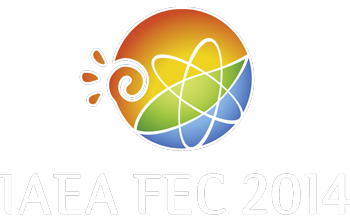Speaker
Mr
Shizuo Inoue
(Univ. Tokyo)
Description
The high-power reconnection heating has been studied in TS-3, TS-4 and MAST merging spherical tokamak (ST) experiments as a promising solenoid (CS)-free startup with significant heating. The magnetic reconnection plays an important role to ramp-up high temperature ST plasmas, which converts magnetic energies to plasma kinetic energies, increasing poloidal beta value of produced main plasma. An important question is how the magnetic reconnection converts magnetic energy of two ST plasmas into thermal / kinetic energy of the produced ST and whether the high toroidal field decreases the conversion rate or not. We performed the first 2D PIC simulation [1] for reconnection region of two merging ST plasmas and found (1) significant ion heating and (2) its fast conversion from poloidal magnetic energy into ion kinetic energy under high toroidal field condition. We also found that the kinetic effects plays important role for its energy conversion. Electrons are accelerated by the reconnection electric field with existence of the toroidal field, forming the quadrupole structures of electrostatic (ES) potential. The electrostatic potential optimizes ion current profiles against new in-plane electromagnetic electric field, causing significant energy conversion from magnetic energy to ions kinetic energy. The physical origin of ES potential is parallel acceleration of electrons, indicating that the Hall MHD regime is not sufficient to describe phenomena. Second, we scanned the toroidal field from 1/4 to 4 of the constant poloidal field in the simulation. We found that the peak ion temperature slightly increases with toroidal field. Finally, the TS-3 merging experiment also reveals that the ion temperature weakly depends on the toroidal field under the constant inflow condition. The series of numerical and experimental results agree well with the recent MAST experiment under collisionless and high toroidal field condition.
[1] H. Ohtani, et. al., Plasma and Fusion Research, 4, 024 (2009).
| Country or International Organisation | Japan |
|---|---|
| Paper Number | ICC/P4-48 |
Author
Mr
Shizuo Inoue
(Univ. Tokyo)
Co-authors
Prof.
Chio Zhong Cheng
(University of Tokyo)
Prof.
Ritoku Horiuchi
(National Institute for Fusion Science)
Prof.
Yasushi Ono
(University of Tokyo)

